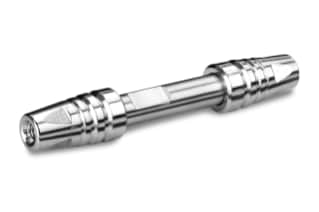
|
Chemistry |
PFP/Fluoro-Phenyl |
|
Separation Mode |
Reversed Phase |
|
Particle Substrate |
Silica |
|
pH Range Min |
2 pH |
|
pH Range Max |
8 pH |
|
Maximum Pressure |
10000 psi (690 Bar) |
|
Endcapped |
No |
|
Bonding Technology |
PFP |
|
Silanol Activity |
High |
|
Particle Shape |
Spherical |
|
Particle Size |
2.5 µm |
|
Endfitting Type |
Parker-style |
|
Pore Size |
100 Å |
|
Format |
Column |
|
Surface Area |
230 |
|
System |
UPLC, UHPLC |
|
Particle Technology |
HSS |
|
USP Classification |
L43 |
|
Inner Diameter |
4.6 mm |
|
Length |
75 mm |
|
Carbon Load |
7 % |
|
UNSPSC |
41115709 |
|
Brand |
XSelect |
|
Product Type |
Columns |
|
Units per Package |
1 pk |

XSelect HSS PFP Column, 100Å, 2.5 µm, 4.6 mm X 75 mm, 1/pk
Due to a complex interplay of retention mechanisms, the XSelect HSS PFP column, a low coverage, un-end-capped pentafluorophenyl phase, offers superior separation of chemically similar compounds as well as alternate selectivity to conventional alkyl chain columns. A seamless transition path to UPLC adoption is made possible by the inclusion of 2.5 µm eXtended Performance [XP] columns in ultra-low dispersion hardware, which provides superior separation performance, resilience, and throughput for HPLC tests.
One of the most dependable, repeatable, and scalable silica-based PFP LC columns on the market is the XSelect HSS PFP Column. True PFP performance is delivered by the special HSS substrate and PFP ligand combination without losing peak shape or retention time variation. High Strength Silica (HSS) technology is used in the XSelect HSS PFP Column. This procedure was created with chromatography in mind and offers advantages, including enhanced polar molecule retention and flexible selectivity. In addition to its analytical powers, the HSS particle possesses the mechanical strength to sustain UPLC pressures.
A special phase for base and planar aromatic chemical selectivity is provided by the XSelect HSS PFP Column. Rely on the XSelect HSS PFP Column when improved compound retention is necessary, especially for polar basic analytes whose retention is challenging with C18 stationary phases. These ligands will interact with Lewis base-containing molecules pi-pi because PFP phases are electron acceptors. Based on the structure, dipole moment, and interactions with hydrogen bonds of the analyte, the stiff aromatic ring provides improved selectivity.
Our website will allow you to shop for lab equipment, and you will also have the choice to contact a member of our international staff for support. You may also be interested in XSelect HSS Phenyl XP VanGuard Cartridge, 100Å, 2.5 µm, 3.9 mm X 5 mm, 3/pk; By eliminating particle pollution from the mobile phase stream, XSelect HSS PFP VanGuard Cartridges are utilized to increase analytical column lifetime and performance. All 4.6 mm I.D. XSelect HSS PFP analytical columns with 2.5 µm sorbent particles are protected by this cartridge.
How Do You Get Enrichment in Low Concentration Sample Components?
To enrich sample components that are present in low levels, many approaches might be used. To selectively elute analytes, the gradient stages can be changed. Utilizing "huge" sample quantities in an adsorption-promoting solvent is another successful tactic. Use a desorption-friendly solvent with a "small" collecting volume. Use sorbent chemistry specific to the analyte instead of the chemistry found in the analytical column. The chemistry of the solid-phase extraction column must be carefully determined in order to prevent the necessity for additional sample preparation.